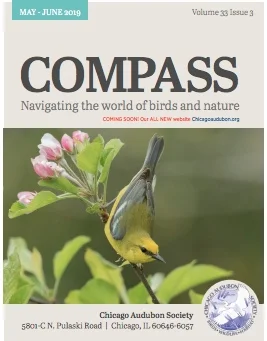Detective Jejeune is delighted to be posted to England's birding hot spot. He would rather be birding than solving crimes, and sometimes fantasizes of a career in ornithology. He is younger than many of the local constabulary; his passion for birds and unorthodox methods further hinder his fitting in to the tight knit community.
A Letter from the President: Exciting Changes to Our Communications
Action Alert: Contact Your Representatives in Congress to Support the Migratory Bird Protection Act
In 2017, the U.S. Department of the Interior severely undermined one of our nation’s oldest and strongest bird conservation laws — the Migratory Bird Treaty Act. The MBTA has long provided the oil and gas industry, wind energy development companies and power transmission line operators with an incentive to work with the U.S. Fish and Wildlife Service and conservation groups to minimize bird deaths. However, now, companies are no longer responsible for reducing bird deaths…
Action Alert: Bird Friendly Design Ordinance
Action Alert: Illinois Bird Safe Buildings Act
Audubon is working on a bill in the Illinois General Assembly that would incorporate bird-friendly design into the construction and renovation of state-owned buildings. Please do so by 1:00 pm Wednesday, February 26,
as the Illinois Bird Safe State Buildings Act (H.B. 4476) will be voted on in committee and we need you to speak up for birds!
Compass Newsletter, January-February 2020
Montrose Action Alert! CPD declines birding organizations’ request for large events policy
Montrose is a special place that deserves protection from the worst abuses. In July, 2019, twelve Chicago bird clubs, nature conservation and community organizations delivered a petition requesting that Chicago Park District work with stakeholders to create a policy defining the limits on large events at Montrose. Recently, the CPD declined our request - we are taking action, and need your help.
Monty & Rose Guest Book
Compass Newsletter, November - December 2019
Action Alert - Cook County Forest Preserve Referendum
Stettner's Silk Moth
Compass Newsletter, September - October 2019
Compass Newsletter, July - August 2019
Updates on Montrose Piping Plovers
Compass Newsletter, May - June 2019
Spring Bird Count 2019
Spring Bird Count - 2018 Report
Chicago Audubon Native Plant Sale - Spring 2020
Winners of the Chicago Audubon Third Annual Photo Contest
An Unexpected Long-Distance Traveler
by Annette Prince, Director, Chicago Bird Collision Monitors Chicago Bird Collision Monitors (CBCM) receives more than 10,000 calls each year from people reporting birds in need of help. One of the more remarkable calls this past spring came from North Chicago (Lake County). A young person called the CBCM hotline (773-988-1867) to say that her mother had found a bird lying in the street near their home. The family had safely contained the bird in a closed cardboard box and was looking for help to get it to a wildlife rehabilitation center. North Chicago is quite a distance from most of our network, but the young lady and her mother were determined to find help for the bird they had rescued, so I made the drive to pick up the bird.
When I arrived, they showed me the spot where the bird had been lying in the street at the end of an alley. The mother said the bird couldn’t walk or fly and was dragging itself in the street — sure to be hit by a car if she didn’t move it. This being a residential suburban neighborhood, I was expecting nothing more remarkable than a pigeon, robin or sparrow — but during migration you never know! I was surprised when they brought out a large computer box.
Even though the residents assured me the bird could not fly, we NEVER open a container and risk the bird escaping. So I carefully peeked into the box, expecting to find a little bird crouched in a corner. I was astounded to see not a small backyard bird, but a huge and very impressive loon! It must have crash-landed on the street, as aquatic birds sometimes do when they mistake dark wet pavement for water. Once grounded, loons are unable to take off. Their anatomy is specialized for the aquatic life they live, but is not suited for walking on land. To take flight, loons need at least 100 feet of open water to paddle/run along to propel and lift themselves into the air. This bird would surely never have left the street on its own.
I transported the loon to Willowbrook Wildlife Center in Glen Ellyn. Upon examination it was found to have multiple grave injuries from which it could not recover, including a broken beak, necrotic foot sores, and primary feather and bone damage to its wings. Sadly, this beautiful bird could not be saved, but it was donated to the Field Museum, where an amazing discovery was made! Initially thought to be an immature or winter-plumaged Common Loon, experts at the museum recognized the delicate necklace below its throat that identified it as a Pacific Loon — a bird normally only seen thousands of miles from North Chicago! Key details leading to the identification were the small body and bill size, dark back with limited spotting, extensive and sharply demarcated dark area on the neck in addition to the diagnostic necklace. This species is a coastal or offshore migrant. It is rarely seen inland, and only very rarely in the Midwest. According to the Cornell Lab of Ornithology, the Pacific Loon is “perhaps the most abundant loon in North America. It spends most of the year on the Pacific Ocean, returning to inland Arctic tundra lakes only for three months in summer to breed.” To read more about the Pacific Loon and other loons, visit https://www.allaboutbirds.org/guide/Pacific_ Loon/
This was the first Pacific Loon specimen from Illinois to be added to the Field Museum collection, where it will be available for research for generations to come. The Chicago region is on the path of many birds making remarkable long-distance journeys. It is important to always be alert for any birds that need our help. You never know what surprising travelers you may find! CBCM welcomes your calls and also welcomes volunteers and donations which allow us to continue rescuing and protecting our feathered friends.
























